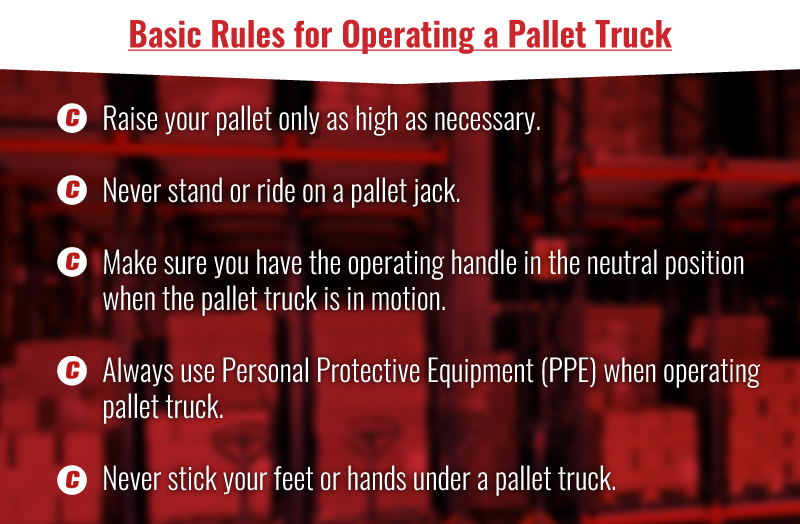
Wherever you find a loaded pallet, you’re likely to find a pallet truck close by to move it. Pallet trucks, or pallet jacks as they’re widely known, are used in nearly every industrial, warehouse, wholesale and even big-box retail facility across the nation. Countless American workers use these indispensable pieces of material handling equipment. Many pallet truck operators are very familiar and proficient with moving large loads with their pallet trucks, yet accidents still happen.
Almost all pallet truck accidents are preventable. Although the contributing reasons for pallet jack mishaps vary, the root cause for most pallet truck accidents is human error. Unfortunately, pallet jack safety is something that’s often taken for granted in some businesses, and it’s here where the majority of incidents causing personal injury or property damage are highest. They don’t have to be.
If companies rigidly follow pallet jack safety procedures, it significantly reduces the odds of having an accident. Initiating a hand pallet truck safety program in your facility might sound excessively cautious, but an ounce of prevention is always worth a pound of cure. That’s especially true when it comes to manual pallet truck safety.
Jump To Sections:
- Pallet Truck Accidents and Injuries
- Focus on Safety: Tips on Proper Pallet Truck Usage
- Manual Pallet Truck Safety Tips
- Pushing vs. Pulling a Manual Pallet Truck
- Safety Tips for Electric-Powered Pallet Trucks
- Proper Training for Electric Pallet Truck Operators
Contact us online Give us a call at 877-350-2729
Pallet Truck Accidents and Injuries
You might think pallet truck accidents are rare, infrequent or minor in nature, but that’s not what statistics show. Material handling is always risky, and a warehouse environment presents a high percentage of industrial accidents and injuries. Many incidents involve the improper or careless use of pallet trucks that resulted in serious injuries. The majority of pallet truck-related injuries are back strains. However, foot and hand crushes also often happen with improper pallet jack use.

This work is licensed under a Creative Commons Attribution-NoDerivs 3.0 United States License.
The Occupational Safety and Health Administration (OSHA) dictates clear and strict regulations governing pallet truck use. That includes both manual pallet jacks and electrically-powered units. OSHA statistics show that 56 serious injuries resulted from improper pallet truck operation between 2002 and 2016. Four pallet jack accidents were fatalities. Eight incidents resulted in workers needing limb amputations. Twenty-five workplace pallet truck accidents caused fractures, and an uncalculated amount of incidents contributed to serious back strains.
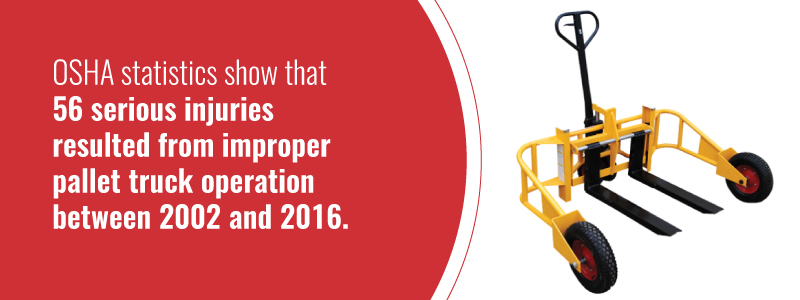
Back strains are far too common in American workplaces. The U.S. Bureau of Labor Statistics published that over one million workers suffer back strain injuries annually. Back strains comprise one in every five workplace injuries and amount to 25 percent of workers’ compensation claims. This costs billions of dollars to the United States economy, and some of it could be saved by paying attention to basic safety procedures when operating pallet trucks.

Preventing pallet truck injuries requires attention and dedication on both the employee’s and employer’s part. Two of the biggest contributors to pallet jack accident are the lack of proper training and simple complacency. Both can be overcome with implementing pallet truck safety protocols and ensuring workers are knowledgeable and compliant in operation.
To help improve your team’s performance in the warehouse or on the loading dock, it’s best to build an education program. That starts with outlining the basics of safely handling all forms of pallet jacks as well as reviewing the safety principles of loading pallets themselves. Pallet truck safety goes hand-in-hand with pallet safety as the two components combine to present potentially hazardous situations. Here are some pallet jack safety tips, starting with manually operated pallet movers.
Focus on Safety: Tips on Proper Pallet Truck Usage
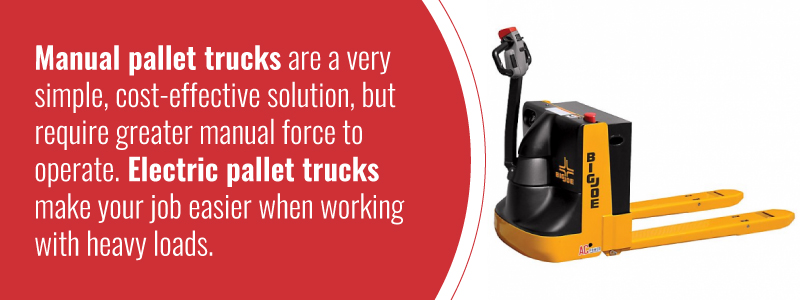
It is vital to use proper best practices when operating pallet trucks, because the safety of your employees depends on it. Manual pallet trucks are a very simple, cost-effective solution, but require greater manual force to operate. On the other hand, electric pallet trucks do the heavy lifting for you, making your job easier and more feasible when working on loads with heavy weights. Each type of pallet truck has its own safety concerns due to the different manner of use. Read on to learn more about safe usage of manual and electric pallet trucks.
Contact us online Give us a call at 877-350-2729
Manual Pallet Truck Safety Tips
There are many different models of pallet trucks on the market, and they’re supplied by a variety of manufacturers. Although this assortment of material handling equipment all has different features like load capacities and safety devices, pallet trucks can be divided into two separate categories — manual pallet jacks and powered pallet trucks. These two groups may serve the same general purpose of transferring pallets from one location to another, but OSHA views them as being different when it comes to operator safety training.
Under OSHA rules, manual pallet jacks can be used by anyone without being trained in safe and proper use. This official view changes as soon as a pallet truck is powered by anything besides human muscle. Electrically-powered pallet jacks comprise the vast majority of powered trucks, followed by a small number of specialty outdoor pallet jacks propelled by gasoline or propane internal combustion engines. Actual forklifts are not considered pallet trucks by OSHA. Forklifts are specifically identified and require a more advanced form of training.
However, just because manual pallet jacks do not require OSHA formal training and documentation doesn’t mean there aren’t safety risks associated with even the lightest capacity trucks. The same safety principles apply whether workers are operating a 3,000-pound capacity jack or a huge model capable of lifting over 10,000 lbs. People can be injured just as severely, and property can also be damaged by improper operation of any pallet jack. Let’s look at some tips on safely handling manual pallet trucks:
- Always instruct workers on using a manual pallet jack properly before they are allowed to operate it. That includes each different pallet jack in the facility, not just an overview of pallet trucks in general. The best instruction consists of explaining, demonstrating and then examining the worker to make sure they’ve retained the information and are comfortable with their operating skills.
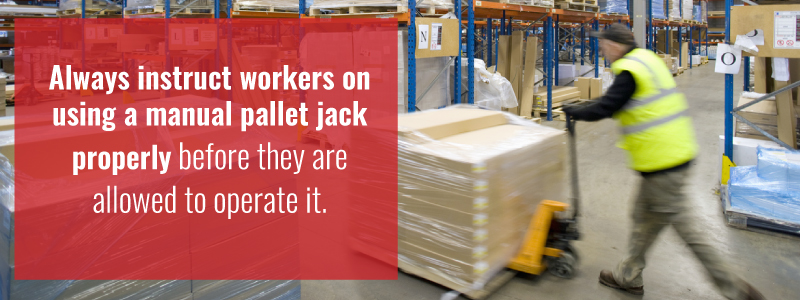
- Even though OSHA doesn’t require formal training for operating manual pallet jacks, details of who has been trained, when training was completed and what specific model was demonstrated should be documented and retained. This sets a professional tone in the workplace and doesn’t suggest a casual company attitude toward pallet jack safety.
- Refer to the manufacturer’s operating instructions. Most models will come with an owner’s manual that spells out features that are unique to that pallet truck model. Carefully reading the manual should be part of the training sign-off.
- Always inspect the pallet jack before operating it. Look for any cracks in the frame or evidence of stress. Wear and tear happens to all material handling pieces, and it could result in catastrophic failure, a collapsed load and serious damage or injury.
Here are some additional safety tips before you or your employees begin operating a manual pallet truck:
1. Check the Overall Soundness of the Machine

The pallet trucks components all work together for it operate, and when a part of it, like the wheels, aren’t up to the standards they should be, a pallet truck can be rendered unsafe — and inefficient. Be sure to inspect following:
- Check the pallet truck’s wheels before loading it. This doesn’t have to be done with each load, but it’s wise to make a wheel inspection at the start of every shift. Look for imperfections such as wobbling or flat spots that make operation difficult and hazardous.
- Test the pallet truck’s hydraulic lift before loading a pallet. Ensure the handle functions properly in the raise, lower and neutral positions. Look for any signs of leaking hydraulic fluid such as drips or stains where the jack has been parked.
- Ensure the forks are freely operating. It’s common for pallet debris to lodge in the fork adjustment spaces and jam the tines. Take the time to work the forks and clean out any foreign material that might stop fork movement.
2. Be Familiar With the Operating Capacity of the Pallet Jack and Your Route
It’s difficult to operate a machine safely if you aren’t familiar with its operating capacity. It’s also ideal to make sure you’re aware of any potential hazards along your route of travel with the machine:
- Make sure you know the individual pallet jack’s capacity as rated by the manufacturer. This figure will be the maximum weight the truck can carry, not a recommended limit. It’s always best never to reach this maximum rating and stay well under the threshold. If in doubt, always opt for a larger capacity pallet jack or separate the load into lighter groups.
- Plan your trip in advance. Ensure you know your destination and be aware of the hazards along the travel route. This might be narrow aisles, tight corners, inclines or intersecting paths with other machine travel. Having good situational awareness is fundamental to pallet jack safety. You have to know what’s around you at all times.
3. Use Common Sense When Operating the Pallet Truck
A little bit of common sense is involved to ensure you or your employees stay safe during pallet jack operation. Take a look:
- Raise your pallet only as high as necessary. The recommended average is one inch off the floor as this keeps the pallet’s center of gravity down and creates a much more stable movement. If obstacles such as an uneven floor or change of slope occur, raise the pallet only enough to clear the obstruction and then lower it back to an inch of clearance.
- Never stand or ride on a pallet jack. Do not carry a passenger, nor use the pallet jack as a stepping device. Although it shouldn’t have to be mentioned, horseplay is never allowed in a workplace, and that includes all inappropriate actions with a pallet jack.
- Make sure you have the operating handle in the neutral position when the pallet truck is in motion. This prevents any accidental and sudden lowering that can immediately stop the jack and cause the kinetic momentum of the load to continue and topple.
- Always use Personal Protective Equipment (PPE) when operating pallet truck. At the minimum, this includes approved footwear that has toe protection and an anti-slip design. Workers should always wear good leather gloves when handling pallets and pallet jacks. Many facilities also require high visibility clothing (Hi-Vis) as well as eye protection and head gear. Back restraint belts are also helpful in handling pallet jacks.
- Never stick your feet or hands under a pallet truck. If you have to remove something from the underside, use a tool or some device to lift the pallet jack and complete the task. Always treat a pallet jack as a potential pinch point, and never put yourself in the line of fire.
4. Start Slowly
Slowly start a pallet truck into motion. Never jerk or whip a jack by the handle as this will place a sudden strain and shock on your muscular-skeletal system. This is a leading cause of injury from pallet jack operation and is easily avoided by putting gradual force on the truck’s handle. Here are a few other tips to help ensure you avoid injury during routine operations:
- OSHA’s recommended transfer of force by a worker to a loaded pallet truck is 50lbs. That’s the same force required to lift a 50 lb object. As well, apply the same rules as lifting when using a pallet truck. That’s keeping your back straight and bending your knees before rising.
- Head and body alignment is also important to avoid strains when operating a manual pallet jack. It’s recommended to keep your head upright and not twist too far to either side. Also, avoid tilting your head up or down too far. As well, your torso should not bend forward at the middle, as much as possible.
- Watch for unstable surfaces like rough or wet floors. If it’s necessary to traverse a loaded pallet truck across questionable spaces, make sure you ask for help. It’s far better to be safe than sorry when crossing slick surfaces.
- Be especially careful on ramps. Even a slight incline or decline can have a drastic effect on gravitational force. Your load may freewheel without warning. It can easily increase speed beyond your control and collide with other objects including nearby workers. Remember, few manual pallet trucks have brakes, and the only way of stopping a moving pallet jack is with your hands or by lowering the load to the floor.
- Keep your line of sight clear. It’s best practice not to load a pallet truck so the material is above your eyes when standing. If tall loads are necessary, enlist the help of a spotter or turn your position so you’re in front of the pallet truck and pulling rather than pushing the jack.
Contact us online Give us a call at 877-350-2729
Pushing vs. Pulling a Manual Pallet Truck
You’ll get different opinions from two different schools of thought about whether it’s correct to push a pallet jack or pull it. There’s no right or wrong answer to this question. When a manual pallet truck is empty, it doesn’t matter whether you pull or push it around. As long as you’re operating in an ergonomically safe and efficient manner, it depends on the direction you want the truck to go. It especially depends if you’re in a tight space and about to load or unload the jack.

Where pushing and pulling really matters depends on the weight of your load and the grade you’re operating in. Under flat circumstances, it’s always best to push a loaded pallet jack. Pushing is easier on the body and doesn’t exert the same tearing force that pulling does. You’ll find it considerably easier to push a loaded truck across a level floor, but that changes as soon as you’re faced with a ramp.
Again, it depends on the weight of your load and the degree of slope. You may find pulling safer and more efficient, especially when you need to use force to brake the load and keep it from free-wheeling. For significant slopes and heavy loads, the best practice is to work with a helper with one in front of the loaded jack and the other operating the handle.
Parking a Manual Pallet Jack
Properly parking a manual pallet jack is another important safety tip. Empty pallet trucks are notorious tripping hazards. That includes being left with the forks extended out into aisle or leaving the handle outstretched. These simple tips about parking a pallet jack seriously improve warehouse safety:
- Always lower the forks to the floor. This makes the pallet truck stable and prevents accidental rolling.
- Park the pallet jack in its designated spot when not in use. That should be out of the way but still accessible without straining. Many facilities with multiple pallet trucks have specific parking stalls. Under open shelves or behind stairwells are good locations for parked jacks.
- Release the hydraulic pressure when parking a pallet truck. This saves stress on the hydraulic pump, lines and cylinder. It also adds to equipment life and lowers maintenance.
- Store loaded pallet trucks with the handle up. It minimizes tripping potential and avoids worker back strain when putting the jack back into service.
- Never store a loaded pallet jack with the forks raised. This puts unnecessary force on the truck’s working parts, including the hydraulics and tires. It also presents a serious safety hazard if the truck is accidentally set in motion.
- Do not store pallet jacks where any emergency exit or access to emergency equipment is located. This includes first aid supplies and fire extinguishers.
Safety Tips for Electric-Powered Pallet Trucks
Most of the previous safety tips for manual pallet trucks also apply to powered jacks. OSHA divides manual and electric-powered pallet jacks into two separate categories as powered units require more skill to operate. They also normally carry greater loads, which make powered units more dangerous. Therefore, OSHA makes it mandatory for all workers who operate powered pallet trucks to be trained and approved for safe use.
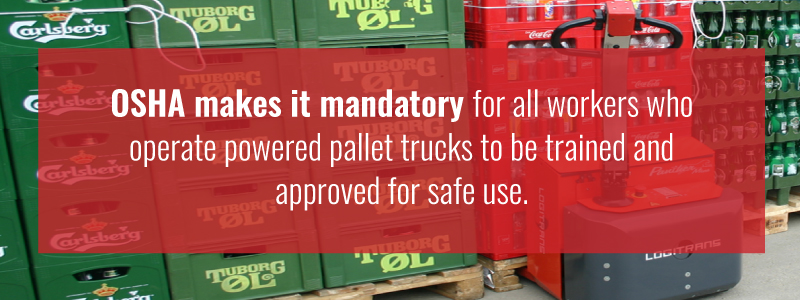
We’ll look at the specifics required for powered pallet jack training, but first, here are some tips specific to safely operating electric-powered trucks:
- Make sure the battery is fully charged. There should be an amperage gauge on the machine that displays the charge capacity or at least tells the percentage of battery life left. A low charge may mean your lift will stop part way through a carry and will require assistance in changing loads. That results in unnecessary downtime and more material handlers, which raise the risk of accidents.
- Test all powered features like the fork’s lifts and spacings. Make sure electric controls are operating, and the truck can turn properly. Make a general inspection for overall condition and record or report any deficiencies. If any serious defects are found, tag the pallet truck as “out of service” and arrange for repairs.
- Ensure electric safety devices are operational. Most electric pallet trucks have emergency shut-offs or kill switches prominently located. This prevents overload or runaway equipment.
- Always examine safety devices like horns or backup warning devices. Also, test the brakes and ensure wheel chocks are nearby for secure parking.
- Check the forward, neutral and reverse controls. Make sure they’re smoothly and positively operating before loading the pallet jack and putting it into service.
- Always shut off the electrical supply when storing a powered pallet truck. Make sure it’s plugged into a recharge portal and ready for the next operation.
Proper Training for Electric Pallet Truck Operators
While proper training isn’t mandatory under OSHA legislation for manual pallet truck operators, the same isn’t true for workers using any form of pallet jack that’s powered by an artificial source. That includes electric powered pallet trucks as well as jacks with internal combustion engines. Practical training is highly recommended for all forms of pallet jack operating, but it’s a must for powered trucks.
OSHA provides a handy “Frequently Asked Questions” publication for powered industrial truck operator training. It covers exactly what employers and employees must know about electric truck operation as well as each party’s responsibilities under the law. These are the OSHA highlights:
- Formal, outsourced training is not necessary. Training can be done in-house as long as the individual certifying a powered truck operator is experienced, knowledgeable and competent.
- An operator must be informed about the general principles of safe truck operation, the type(s) of vehicles they’re to be operating, the individual workplace hazards and the general OSHA safety requirements.
- Trained operators must know how to do the job properly and demonstrate it through workplace evaluation. This can be accomplished by verbal and written lessons, pertinent videos and followed by practical observation.
- Employers must recertify operators once every three years. All training and results must be documented. Actual certificates are not necessary such as they are for forklift operators.
Safe & Practical Pallet Truck Solutions from Cherry’s Material Handling

Pallet truck safety is not a subject to be taken lightly. Neither is supplying pallet jacks. Cherry’s Material Handling has been providing material handling equipment like quality manual and electric pallet trucks to owners and operators across America for over three decades. Cherry’s Material Handling takes safety seriously and wants you to work safely, too.
Cherry’s Material Handling has knowledgeable sales staff who have experience with all forms of pallet jack equipment. We’ll be pleased to discuss our extensive line of manual and electric pallet trucks that range in capacity from light to heavy-duty machines.
Contact us online Give us a call at 877-350-2729
Page updated on: February 18, 2021

